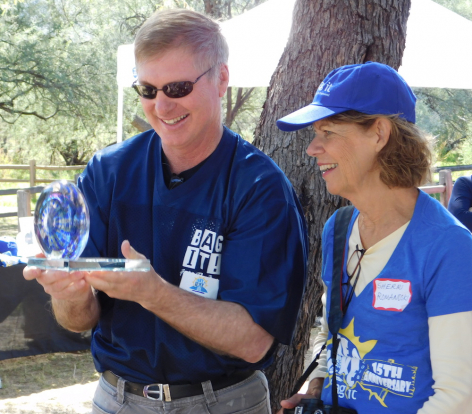One breast cancer survivor’s story of turning a personal patient solution into a community solution
By: Lori McNeill
Sherri’s Story
“I was shocked.” This, perhaps not surprisingly, was Sherri Romanoski’s response to being told back in 2000, at the age of 48, that she had breast cancer.
“It hit me hard. I was full of fear,” said Sherri.
Along with that fear can sometimes come a sense of powerlessness—how do I combat a disease I don’t fully understand?—and a lot of questions. What’s my cancer treatment plan? How long will it take? What can I do outside of the doctor’s appointments right now to help make a positive difference? How do I tell my family? What do I share, if anything, at work? What do I do about side effects? How am I going to pay for all these medications?
How can someone like Sherri, someone newly diagnosed with cancer, find answers, and empower herself to not just cope but find support, learn to communicate with her doctors and her loved ones, move forward on this unexpected new journey, and even thrive?
Sherri took these questions and not only found answers for her own journey but answers she could share, through a non-profit program called Bag It.
But let’s go back to that first appointment of Sherri’s after her diagnosis …
“I was … surprised.”
“I was … surprised at how little information I was given along with my diagnosis,” commented Sherri. She describes the detail she received as incorporating two pieces of paper and a drawing, maybe a list of side effects. This didn’t seem like much to someone just diagnosed with a disease she didn’t see coming, didn’t fully understand, and requiring long-term treatments she didn’t completely comprehend yet.
As a Kindergarten teacher who also worked in the behavioral health field, however, Sherri was no stranger to finding solutions to challenges. She took a look at some resource bags she was putting together for her students’ parents and thought, “I need a bag.”
She added a three-ring binder to fill with questions and answers, and information and helpful resources relating to her cancer diagnosis and treatment. A binder that would keep all of the information she gathered and collected in and outside of her doctor’s office in one place, in one folder that she could carry with her, reference, and share as she saw fit with her support network.
Sherri created that binder for herself and asked a lot of questions of her Arizona Oncology cancer doctor.
“I felt empowered because I was asking the questions,” she said.
Sherri asked so many questions that during her last appointment following her last treatment she stood up and unrolled a long ream of attached computer paper (the type they used to have back in the day, with the holes punched in the sides and the green and white lines). “I just have a few more questions,” she joked.
The Bag It Story
“If it helped me, it could help someone else.”
Once Sherri finished her treatment, she thought about all of the other cancer patients in her community going through a similar journey. She thought about her binder, a bag full of educational information, questions and answers, treatment details, and more. “If it helped me, it could help someone else.” If it empowered her, it could empower someone else.
Sherri knew a lot of the educational information needed was out there, available from reputable sources like the American Cancer Society, the National Institutes of Health (NIH), and more. She gathered and organized the information she thought could be most helpful, but she didn’t just rely on her own experience. She showed the information to doctors and the Southern Arizona Nursing Society. She showed it to cancer survivor groups and support groups. This is how she made the initial decisions of which information would be included in the binder and the bag.

Then she spent two hours telling the office manager at the Arizona Oncology office that she had counted on for much of her treatment, why physicians distributing this free resource—these binders in a bag—could truly make a difference. Not only would Bag It provide patients with education and support resources, it would help physicians answer their patients many common questions in a place where patients could maintain and refer back to the information, even if they forgot what was said in the doctor’s office. Doctors often encourage cancer patients to bring someone with them to their office visits, so they have a second person to hear treatment information. The Bag It binder could help both the patient and caregiver remember personal health and history details and treatment instructions, track test results, and keep support contacts.
Arizona Oncology decided to give it a shot. The first bag featuring Sherri’s binder and information, the first Bag It, was distributed in July 2003. 75,309 bags have been distributed since, free of charge to cancer patients.
“I’m on my fourth binder,” says Sherri. “I take it to every appointment.”
Doctors are seeing the benefit of Bag It to cancer patients, as well.
Bag It supports the community, and the community supports Bag It.
“I’m going to tear up,” Sherri told Program Coordinator Joyce Palasek, when Joyce told her how one physician gives newly diagnosed patients the bag and binder with the hug that Sherri herself can’t give them, but admits she wants to in the opening letter in the binder.
The tears make sense. There’s a lot of work, thoughtfulness, determination, and love behind each Bag It bag and binder, yet Sherri knows the presentation by physicians and health care workers makes a tremendous difference, too. She and her team are very grateful for the support that keeps Bag It helping more and more patients across Arizona, and hopefully eventually across the nation.
It took 18 months to originally gather the materials for the binder, get reviews, and start a 501(c)(3) nonprofit organization. Sherri had a friend’s help and support from her oncologist at Arizona Oncology, both of whom were founding members of Bag It and on the board for many years.
Sherri also had the initial help of 25 people who, in hearing about the binder at a friend’s house, without even being asked, started writing checks to help make the project happen.
150 Bag It bags and binders were distributed each month, when they first started. They were put together on Sherri’s kitchen counter.
“It took a few years to get it into (doctor’s) offices,” Sherri said. The Bag It program started in Tucson, with Arizona Oncology offices, soon moved to other, rural communities, and finally into Phoenix. The binder information is also available in Spanish now.
Distribution grew, but the information that was readily available before became more controlled and limited and had to be ordered. Printing costs came into play. The Bag It team needed help with funding. They had to change their model.
The Bag It team didn’t shy from the challenge. They hold a fundraising hike in Tucson every November and a special fundraising event in Phoenix each spring. They encouraged the support of sponsors in the pharmaceutical and medical communities, and from community businesses. The Beacon Group works with the Bag It team to assemble the bags and volunteers are ambassadors for the bags at local events.
And they always keep in mind the Bag It purpose and look for ways to make it even more helpful to both patients and physicians.
The Work and the Love Behind Bag It Continues
The Bag It team, led by Executive Director Mindy Griffith and Program Coordinator Joyce Palacek, recently put even more research behind improving and perfecting the binders to provide the best patient experience. Once again, they talked to cancer survivors using the binders, doctors, and nurses. The results, seen in the 2019 Bag It bag and binder released just this month, are exciting. The bulk of the binder was slimmed down. Tabs divide information by function, rather than by stage of treatment: “My personal details”; “my test results”; “from my healthcare team”. Booklet information was condensed in some cases, to be more digestible for multiple audiences. Larger print makes the texts more readable. Vetted online resources are included. Binders are customizable by patients and their physicians. The result is a lighter weight binder still offering a plethora of educational materials, support resources, and simple tools for tracking and keeping information … it’s all in the bag.
“Mindy’s leadership has moved the Bag It program on to this new version, new logo and look, and it is truly an amazing endeavor,” said Sherri. “The result is outstanding. It is Mindy and the Bag It staff that have made this happen.”
And in every bag, is Sherri’s heartfelt letter. In every page of the binder is the commitment and dedication of a cancer survivor who once sat where many others sit, in a doctor’s office trying to absorb the shock of a diagnosis no one wants to hear; in the car on the way home fighting the fear of what’s to come; and surprised day in and day out by the seemingly unending questions that keep popping into one’s thoughts.
There are answers. There is support. There is power in knowledge. “Some days will be easier than others,” Sherri says in her opening letter in the binder, “just knowing that helps.”
And, it’s true, says Sherri … you are your own best advocate in your cancer journey. Bag It is her way, the team’s way, and one way many local physicians are helping every patient feel empowered and supported throughout their treatment and survivorship.
As for Sherri’s personal story, while she may be retired from teaching after 25 years, she continues to educate and empower cancer patients through Bag It and similar opportunities. She also spends time with her grandchildren. Cancer may have been a plot twist she didn’t see coming, but it’s only a piece of her much greater story and now her community’s story.
Originally posted in 2019, updated in 2024.



